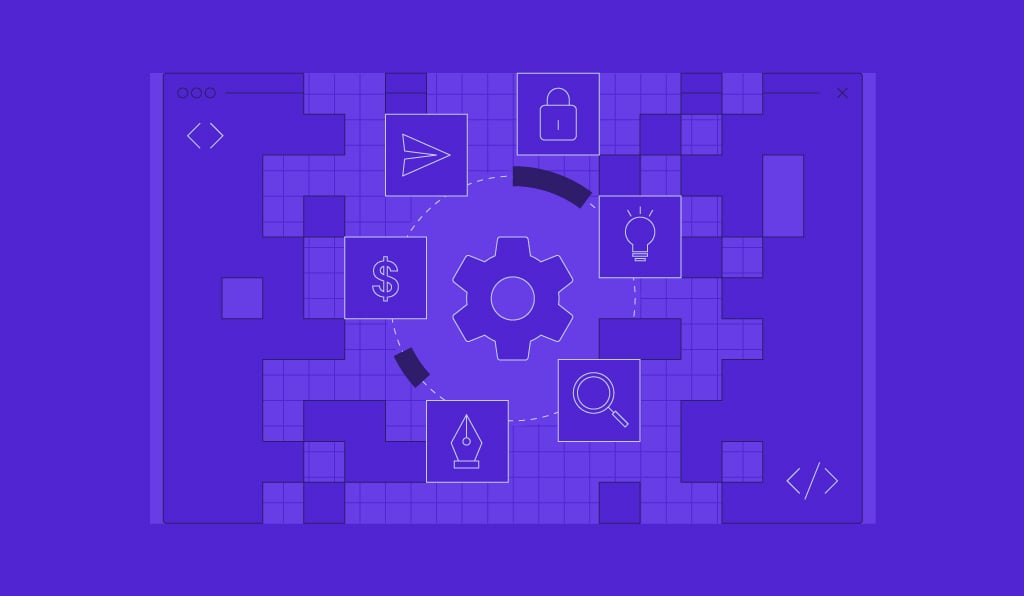Web Development Proposal: Best Practices + Examples

A web development proposal outlines an agreement between a web developer and a prospective client. The written document conveys details of the client’s requirements, offered web development services, and the agreed-on timeline.
Knowing how to create web design proposals is a valuable skill to get potential clients, especially for freelance web developers and designers. For example, due to the information contained in a project proposal, many graphic designers use it as a base for creating a pricing structure.
Download web development proposal template
However, it shouldn’t be confused with a contract, which is a legally binding agreement.
This article will go through a web development proposal’s content, including what essential elements to add and how they can affect the whole project. We’ll also provide a free web development proposal template as a guideline and tips to create fantastic proposals that win clients.
What Is a Web Development Proposal?
A web development proposal is a written agreement between a web developer and their potential client. It contains detailed information about the requested web development services, the client’s expectations, and the agreed timeline.
What to Include in a Web Development Proposal
Whether you’re a freelance web designer, a developer, or a project manager, any professional web development process must start with project planning. Narrowing down the project scope and objectives helps align your capacities and the client’s requirements, ensuring both parties are on the same page and get what’s agreed upon.
For this reason, it’s important to prepare your web development proposal template properly. While there is no fixed structure to follow, the web development proposal should convey all the information needed for the communication between the client and the service provider.
To accomplish this, an excellent project proposal must have the following elements:
Executive Summary
Like developing a business plan, a website development proposal commonly starts with an executive summary. This section showcases the project overview divided into two parts ‒ the problem statement by the prospective client and the proposed solution by you as the service provider.
Problem Overview
For projects auctioned in competitive bidding, the project overview section should focus on the issue within the client’s business, such as improving their web presence or taking advantage of a missed opportunity.
If the client comes to consult with your agency personally, cover the problem that comes up during the interview. Make sure to include any challenges you or your team can solve in the web design proposal.
The goal is to get the client’s attention and create a sense of trust, showing that you understand their problem or missed opportunity and how to address it. In other words, you’d want the client to see you as the right person for the job.
Proposed Solution or Objectives
Your project proposal’s solution overview section should point out how your web design solution can benefit the client’s business.
For instance, proposing a web design project that works well on desktop and mobile devices can improve user experience, search engine optimization (SEO) performance, and bring in new customers. Maybe you want to build a website for your client with an accessible layout design, increasing the company’s positive brand awareness.
You can go the extra mile and do extensive research on the company’s business model and stakeholders to understand the client’s problem better. Doing so will show your commitment to understanding the project requirements and delivering a personalized solution.
Based on your findings, present a sound and feasible solution in simple business and design terms.
While such a website design proposal aims to earn you prospective clients, overselling an unrealistic idea will only damage your credibility and cause issues after the project starts.
Scope of Work
Define the project scope by creating a list of products and services the client will receive. The project deliverables are likely to be included in the future contract, so make sure they’re within your or your agency’s capacity.
This section holds both you and the client accountable for what you will agree upon.
As a service provider, you must deliver all the agreed services and compensate in case you fail to do so. On the other hand, the client shouldn’t ask you to work on anything outside the project scope.
Timeline
Once you identify the project scope, break down the client requirements into chronological stages and define the time needed to complete each of them. Since this section determines the launch date for the project, plan the timeline carefully so you can finish it as scheduled.
The following is a list of the most common stages of a web development project you should consider. Feel free to tweak it based on your project’s complexity and requirements.
- Project planning ‒ curate briefs, list the requirements, and establish a detailed sitemap and wireframes.
- Front-end design ‒ create design mockups and decide the number of web pages the website will have.
- Back-end programming ‒ build the website based on the approved design and functions.
- Beta testing ‒ share the offline version of the website with the client for review and feedback.
- Website launch ‒ run the launch process for the new website.
We recommend factoring in possible issues that might affect the timeline. Discuss this matter with your client before drafting the contract.
Expenditure
As the name implies, this section covers the project fee. Break down the exact costs required to complete the web design process with pricing tables. List the prices of your web design services and resources needed, like web hosting and a domain.

Next, decide how you will charge the client. Most web designers use the industry-standard 50/50 payment term – 50% upfront and 50% on completion. Some freelancers enforce the 50/40/10 payment term, with 40% being paid after a specific project milestone and 10% before the site goes live.
Alternatively, establish payment milestones based on the project timeline and resume the project only after the client has made the payment. This method lets the client monitor your progress and keeps your cash flow positive.
Regardless of the chosen payment plan, we recommend asking for an initial payment of some percentage of the total project fee before starting to work.
Contact
This final section should contain your contact information and ways for the client to reach out to you. If you work with a team, add the project manager’s contact details here.
We also recommend stating your business hours to establish a healthy client-contractor relationship. By setting realistic boundaries and expectations, you will have the right to refuse to communicate outside your business hours.
Tips When Creating a Web Development Proposal
By now, you know how to create a proper website design proposal template. However, there’s always plenty of room to improve your future project proposals. Here are some of the best practices for improving a website development proposal:
- Include an About Us section ‒ display a link to your online web developer resume, portfolio, and client testimonials to boost the project proposal’s appeal and build trust. If you work independently, include relevant web development certifications and web development tools you use to establish credibility.
- List possible integrations ‒ this information helps prospective clients plan how to scale the site and make your website proposal even more appealing value-wise. For example, by upgrading to a professional hosting service.
- Keep the project proposal’s design visually appealing ‒ instead of overcrowding the web development proposal template with distracting elements, design it to reflect your branding.
- Define your goals ‒ align your web development plan with the client’s business goals. Don’t confuse your goals with the proposed solution. For example, creating a website is only a means to boost the client’s online presence.
- Research the target audience ‒ this information helps you create an on-point web design that resonates with the client’s target users.
Conclusion
Whether you’re a freelance web designer or own a web development company, knowing how to create proposals that sell is essential. As no web development proposal template fits all types of projects, personalize it according to prospective clients’ requirements.
We hope our tips and free website proposal template will give you a better understanding of how to write proposals that win clients. Good luck!
Web Development Proposal FAQ
Here are the common questions and answers about web development proposals.
What Are the Main Types of Web Development Proposals?
The main types of web development proposals are project proposals, contract proposals, and request for proposal (RFP). Project proposals outline a specific project, contract proposals offer services to a client, and RFP proposals respond to a client’s request for services.
Where Can I Find a Web Development Proposal Template?
You can find web development proposal templates on websites such as Proposify, Bidsketch, and TemplateLab. Additionally, many freelancing platforms, such as Upwork and Freelancer, and proposal software tools offer proposal templates that can be customized to fit your needs.



Comments
October 29 2023
Hey, this is really an awesome webpage! Appreciate it for providing all this valuable info.
November 08 2023
Hi there! We're delighted to hear that you find our webpage valuable. If you have any questions or need further information, please don't hesitate to ask ?